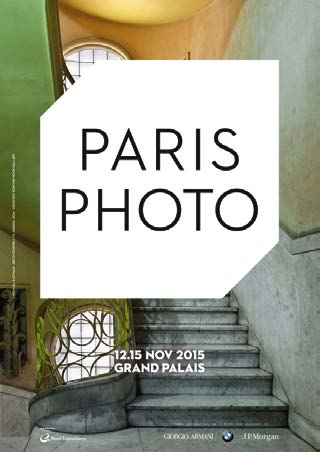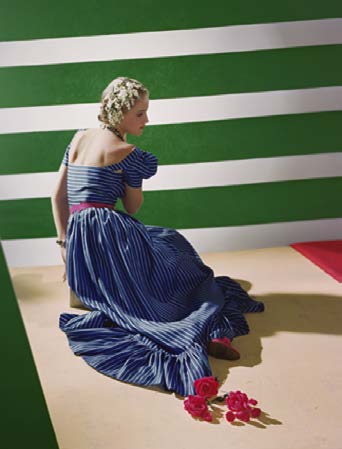Paris Photo 2015
Last year, the terrorist attacks in Paris on 13 November forced the 19 edition of Paris Photo, the world’s largest photography fair, to close its doors halfway through. It should be noted that the two weekend days during which the art fair was closed (like all other cultural organisations in the shocked French metropolis), usually draw the greatest number of visitors. Although the event organisers from Reed Exhibitions reimbursed the exhibitors 20% of the participation fee they had paid and, in addition, contributed towards organising ffty photo exhibition and sale events during the last weekend in November, Paris Photo 2015 cannot be considered a great success for most of the 147 galleries and 27 publishing houses and booksellers that made it to the photography fair.
However, the frst few days of the photo fair were wonderful. Both the new Director Florence Bourgeois as well as the Artistic Director Christoph Wiesner, who replaced Julian Frydman, placed even greater emphasis on making Paris Photo more of composite array of dozens of curated exhibitions rather than a trade fair sales arena with each stand offering an incomplete mix of photographs. A number of galleries exhibited either the works of only one artist or a thematic collection. The new Salon d’Honneur sector provided space to some real fnds. These included, for example, the extensive Farewell Photography exhibition presenting the expressive black-and-white photographs taken by Daido Moriyama – the Japanese pioneer in the feld of subjective documentary. It featured thirty of his photographs that were published in 1972 in the book of the same name, which survived in the Tokyo publishing house in spite of the artist’s efforts to burn all existing volumes of the publication. An additional ffty photographs that were not selected for the book could also be seen in Paris. The exhibition was simply fantastic, proving that Moriyama is an important player in Japanese photography. It also showed how deeply infuenced Moriyama was by the works of William Klein, particularly his 1964 book about Tokyo.
Another highly memorable experience was the exhibition entitled Portraits in the Time of AIDS, featuring the almost forgotten portraits made by American photographer Rosalind Solomon. Although their composition is very simple, the photos are very suggestive, presenting images of people dying of the treacherous disease in the 1980s, at a time when there was no effective treatment for it. Bruce Silverstein’s New York gallery thus provided a reminder of a work, which, for the most part, was very negatively received at the time of its premiere opening in 1988.
The art fair overall brought even more discoveries. These included the Daniel Blau Gallery from Munich, which exhibited a number of almost unknown or never-published naturalist snapshots of New York taken by Weegee in the 1930s and 1940s. The Paris-based Alain Gutharc Gallery presented original period enlargements of photos by Jacques Henri Lartigue, who, between 1920 and 1943, created what were at that time extraordinarily modern honest snapshots of family life. Only a single sample of these particular works has been preserved in a private album kept by the photographer’s son Dany.
Paris Photo presents many more current photography trends than does its main competitor, the AIPAD fair in New York. However, the exceedingly high rent charged for exhibition space in the Grand Palais ultimately leads to the fact that the majority of galleries rely on famous photographers. London’s Atlas Gallery put together its exhibition from the photograms made by Man Ray, Lászlo Moholy-Nagy, Berenice Abbott, Floris Neusüss, and other well-known artists. The Paris-based Karsten Greve Gallery devoted their entire exhibition to Brassaï’s Graffti cycle from the 1930s.
As usual, the leading international galleries offered the works of the renowned artists they represent at exorbitant prices. It was thus possible to purchase the works of Richard Avedon, William Egglestone, Andreas Gursky, Cindy Sherman, and Gregory Crewdson from Gagosian (without any descriptive tags as is traditional, because after all they are generally known artists). David Zwirner was offering the abstract photographs of Thomas Ruff, and Sprüth Magers the work of Bernd & Hilla Becher and Stephen Shore. The most signifcant photo galleries also placed their bets on certainties. London’s James Hyman Gallery was selling Gustave Le Gray’s beautiful albumen print The Great Wave from 1857 for EUR 385,000. The Howard Greenberg Gallery had several wonderful vintage prints by Edward Steichen, Pierre Dubreuil, and Josef Sudek, but the largest section of its exhibition was devoted to the colour documentary photos of Joel Meyerowitz, whose work has lately been attracting great interest. Another New York gallery, Pace/MacGill, lured visitors with a huge panoramic enlargement of a snowy landscape by Josef Koudleka, to which they devoted an entire wall, and also offered the works of Robert Frank, Harry Callahan, Hiroshi Sugimoto, Hira, and other famous artists from the immediate post-WWII era. During the first two days of the art fair, the Chicago-based Stephen Daiter Gallery sold photos by Lászlo MoholyNagy and Irving Penn. Works by the traditional representatives of Czech photography – František Drtikol, Jaromír Funke and Jaroslav Rössler – were offered by, for example, the Robert Koch Gallery from San Francisco, the Berlin-based Kicken, and the Johannes Faber Gallery from Vienna.
Unfortunately, there was once again no Czech gallery at Paris Photo. The exhibitors did, however, include the Vintage Gallery from Budapest, which offered a wide selection of works by Hungarian photographers, ranging from André Kertész to contemporary artists. The Gandy Gallery from Bratislava also participated; however, they did not exhibit works by Slovak artists, but focused on Danica Dakić, a German photographer of Yugoslav origin. The exhibition put together by the Temnikova & Kasela
Gallery from Tallinn was dominated by the homoerotic photographs of Jaanus Samma. In the case of the Warsaw-based Asymetria Gallery, in addition to the works of the classical post-war artists Zofia Rydet, Jerzy Lewczyński and Wojciech Plewiński, for the second time in a row they exhibited works by Anna Orlowska, a graduate of the Institute of Creative Photography of the Silesian University in Opava. (At the previous Paris Photo, her works were purchased by several important museums.) The absence of a Czech gallery understandably greatly limited the opportunity to present the works of the middle and younger generations of our photographers, who are not represented by foreign galleries, at the world’s most important photography fair.
The leaders from the world of fashion photography were once again strongly featured. Not only the works of traditionally well-known artists, including Richard Avedon, Helmut Newton, Lillian Bassman, and Herb Ritts, which were offered for prices ranging in the tens of thousands of euros, but also those of contemporary photographers such as Nick Knight, who was the sole focus of the exhibition put together by the Christophe Guye Gallery from Zurich. The little-known black-and-white photos that Guy Bourdin shot for the advertising editorial of Egoïste magazine in 1987 were on offer by the Louise Alexander Gallery from Porto Cervo.
In comparison, as is traditional, conceptually focused works of photography and from the fields of happenings, land art and body art, which are appearing more frequently at art fairs such as Art Basel, Art Basel Miami Beach, Frieze and FIAC, were less represented. Nevertheless, they were not completely missing in Paris either. For example, the Anita Beckers Gallery from Frankfurt devoted its exhibition stand to photos by Jürgen Klauke and Peter Weibel, which provide a record of their various performances and happenings.
The stands operated by photobook publishers were an important part of the fair. They included both industry giants, such as Taschen, which publishes true blockbusters, as well as small publishing houses that focus on works by young authors. Qualitatively speaking, the Paris Photo – Aperture Foundation Photobook Awards competition was quite unbalanced. Side-by-side competitors included traditional gallery catalogues and comprehensive monographs set against original first works published on newspaper stock in print runs of only a few dozen copies. The main prize was awarded to Daniel Mayrit’s inventive book Illustrated People, published by the London-based Archive of Modern Conflict, which has received many awards for its publications in this particular competition. As has become tradition, Paris Photo included a number of book signings and lectures, however, due to the premature closing of the art fair, only a part of those scheduled took place.
Even though Paris Photo was open for only a short time last year, it was confirmed that it has no real competitors amongst the other photography fairs of today and, quality wise, it far surpasses the Fotofever event that is held during the same time in the mall beneath the Louvre. At the same time, it came to light that this is, to a high degree, thanks to the position Paris holds as one of the world’s most important art and tourism centres, and also undoubtedly due to the magnificence of the Grand Palais where the photography fair has been held the past few years. (However, there is a problem, as major renovations are planned for the building in the near future.) The effort to expand the event to locations abroad, following the example of Art Basel, whose organisers have successfully organised the Art Basel Miami Beach and Art Basel Hong Kong events, did not, however, work out. Although the Paris Photo Los Angeles art fair did attract a fair number of Hollywood stars and other celebrities, it drew the attention of only a few serious collectors. The organiser, Reed Expositions, was already planning a fourth edition of the event for the end of April and start of May 2016 and spent an enormous amount on promotion costs. However, on 15 February, they published a message, shocking many, that they are cancelling the photo fair.
#27 cars
Archive
- #45 hypertension
- #44 empathy
- #43 collecting
- #42 food
- #41 postdigital photography
- #40 earthlings
- #39 delight, pain
- #38 death, when you think about it
- #37 uneven ground
- #36 new utopias
- #35 living with humans
- #34 archaeology of euphoria
- #33 investigation
- #32 Non-work
- #31 Body
- #30 Eye In The Sky
- #29 Contemplation
- #28 Cultura / Natura
- #27 Cars
- #26 Documentary Strategies
- #25 Popular Music
- #24 Seeing Is Believing
- #23 Artificial Worlds
- #22 Image and Text
- #21 On Photography
- #20 Public Art
- #19 Film
- #18 80'
- #17 Amateur Photography
- #16 Photography and Painting
- #15 Prague
- #14 Commerce
- #13 Family
- #12 Reconstruction
- #11 Performance
- #10 Eroticon
- #9 Architecture
- #8 Landscape
- #7 New Staged Photography
- #6 The Recycle Image
- #5 Borders Of Documentary
- #4 Intimacy
- #3 Transforming Of Symbol
- #2 Collective Authorship
- #1 Face


